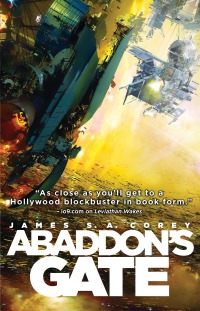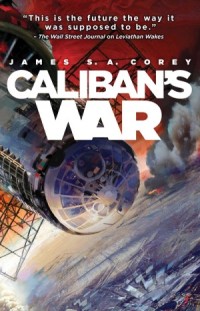The Mercy of Gods by James S. A. Corey
 Wednesday, July 31, 2024 at 8:30AM
Wednesday, July 31, 2024 at 8:30AM 
Published by Orbit on August 6, 2024
The latest project of the writing team known as James S.A. Corey is a classic alien invasion story. It has elements in common with Peter F. Hamilton’s recent Salvation trilogy, in that the aliens take some humans as captives before killing the rest. While Hamilton’s story focuses on humans (and their descendants) who fled Earth and avoided captivity, Corey’s follows the lives of human captives.
The tradition in alien invasion stories is for puny humans to find a way to fight back against a more powerful enemy. And so it is a foregone conclusion that the humans in The Mercy of Gods, when facing a choice between living a reasonably comfortable life as slaves or finding a way to resist, will decide to make a stand. As a character explains: “This is about what we are. As a fucking species.” Yet making an emotionally satisfying but futile stand, while a very human thing to do, might not be the smartest long-term strategy. Whether to fight or wait is the conflict that underlies the first book in the Captive’s War series. (The Mercy of Gods is preceded in time by a novella that hasn’t yet been published.)
As alien species go, the Carryx are nothing special. I visualize them as giant cockroaches but others might imagine them differently. Their social organization is in one respect similar to an ant colony, with a Sovran playing the role of queen who is served by all the other Carryx. The most interesting characteristic of the Carryx is the change in physical form that they undergo when their social status changes (from soldier to Librarian, for example).
The Carryx have roamed through hundreds of solar systems, looking for species to enslave. They’ve been quite successful in that endeavor. The Carryx believe that “rigor and intelligence,” properly applied, will reveal that the universe is expressing an “implacable truth.” Naturally, the truth is that the Carryx are superior to all other beings and are therefore entitled to subjugate them.
The Carryx cherry-pick the most accomplished inhabitants of an invaded planet for relocation on the Carryx home world, then kill an eighth of a planet’s remaining population to show they mean business. The newly enslaved must demonstrate that they have something to offer the Carryx. If they aren’t useful, they’re wiped out in favor of species that can bring something to the table. Producing something of value to the Carryx is the key to survival.
The human characters are scientists living on the planet Anjiin. Earth has long been forgotten as humanity’s planet of origin. When the Carryx invade Anjiin, they select Tonner Freis and his highly regarded research team to join the other worthy humans who will be transported to the Carryx home world. Tonner’s team has been performing biological research involving the proteins of different species. Their project is way over my head, but it eventually becomes important to the story. Fortunately, an understanding of molecular biology isn’t necessary to follow the plot.
Hundreds of intelligent species from a variety of planets are housed on the Carryx home world. After a species is evaluated, its useful members are dispatched to other worlds controlled by the Carryx. Each subjugated species is assigned a Carryx Librarian to catalog their knowledge.
The Carryx have tasked Tonner’s group with changing something that looks like a berry into a substance that will provide nutrition to something that looks like a turtle. The Carryx assigned the same project to a species that resembles Earth monkeys. The monkeys decide that they can gain an edge in the competition by attacking the humans. Violence ensues. The conflict makes clear that humans are competing against every other species and that the Carryx favor the survivors. Comfort, benefits, and greater resources reward species that are useful to the Carryx. Fortunately for readers, it is a given in science fiction that, in the long run, humans will always win competitions with aliens.
Most of the story is a set-up for novels to follow. Characters on Tonner’s research team include Dafyd Alkhor (who isn’t on the same level as the other researchers but used a social connection to join the team), Else Yannin (who was sleeping with Tonner before she started sleeping with Dafyd), Jessyn Kaul (who worries that she will run out of the pills that keep her brain from rotting), her supportive brother Jellit (not really part of the team but he hangs out with his sister), Rickar Daumatin (whose is defined by rage and cynacism), Campar (who uses humor to cover his insecurities), and Irinna (younger than Jessyn but a talented researcher). They all play individual roles in advancing the story and those who survive will presumably benefit from further character development as the series progresses.
The final element of the first book involves a species known as the Swarm. The Swarm pose an actual threat to the Carryx. They’ve gathered information that has enabled defenses and counterattacks against the Carryx. A spy for the Swarm has acquired critical intelligence but must work with humans to transmit that information to other members of the Swarm so it can be put to good use.
A key theme is the morality of harming a small number of individuals for the greater good of the whole. While sacrificing oneself might be an easy choice for a selfless character, sacrificing friends to save a larger number of strangers is a more difficult decision. When do humans have the moral authority to sacrifice others against their will?
Some alien species will likely be beyond human comprehension. Science fiction writers typically create aliens that humans can understand, usually by giving them the lust for power and conquest that we see in humanity’s less desirable members. Through Dafyd, Corey argues that it is necessary to understand a more powerful enemy before the enemy can be defeated. As Dafyd explains to Rickar, the Carryx can be perceived as bloodthirsty monsters, but from their perspective they are carrying out their proper role in the universe.
Dafyd’s ability to understand the Carryx will likely make him the most important character in the series. How Dafyd and the other humans (perhaps with the assistance of the Swarm) will put that understanding to use remains to be seen. Given Corey’s success with the Expanse series, I expect that the humans will concoct clever means to battle the Carryx.
Reviews of the first novel in a series are always conditional. A trilogy that begins with promise might end with disappointment. I can only say that the strong characters and intriguing set-up in The Mercy of Gods give me reason to look forward to the next installment.
RECOMMENDED



